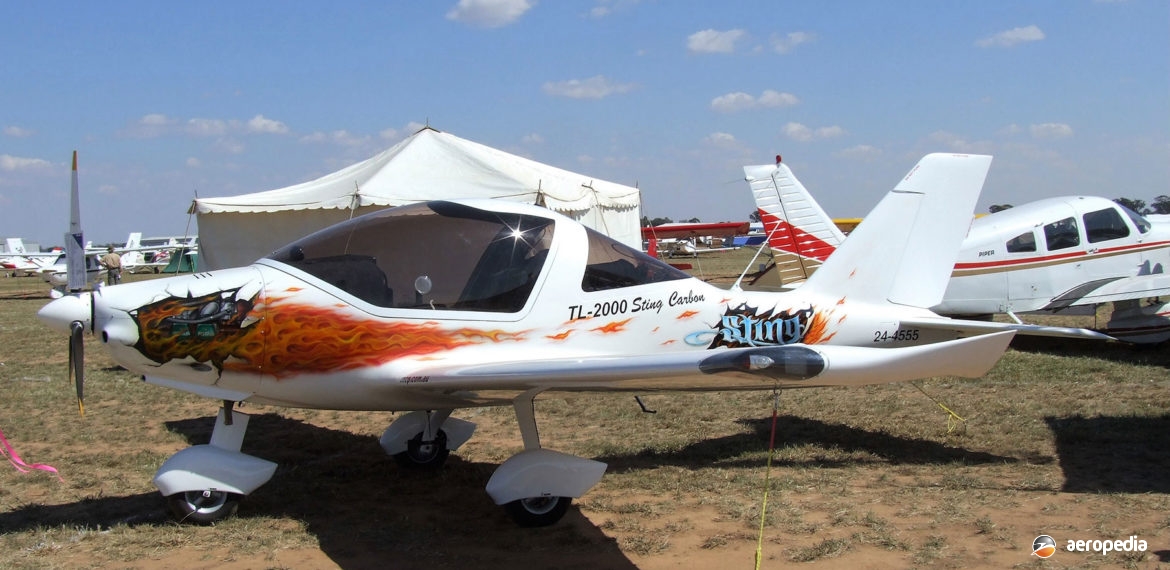Photograph:
TL Ultralight Sting S-4 24-8820 (c/n 16ST450) at Cessnock NSW in September 2018 (David C Eyre)
Country of origin:
Czech Republic
Description:
Two-seat light sport aircraft
Power Plant:
One 60 kw (80 hp) Rotax 912 four-cylinder, four-stroke, liquid-and-air-cooled, dual carburettor, electronic ignition engine
Specifications:
- Wingspan: 8.44 m (27 ft 6 in)
- Length: 5.93 m (19 ft 5 in)
- Height: 2.3 m (7 ft 6 in)
- Wing area: 9.8 m² (105 sq ft)
- Max speed: 280 km/h (175 mph)
- Economical cruising speed: 120 km/h (75 mph)
- Max cruising speed: 260 km/h (165 mph)
- Stalling speed with flaps: 62 km/h (39 mph)
- Rate of climb: 480 m/min (1,575 ft/min)
- Fuel capacity [standard]: 69 litres ( 15 imp gals)
- Fuel capacity [optional]: 100 litres (22 imp gals)
- Empty weight: 300 kg (661 lb)
- Loaded weight: 540 kg (1,190 lb)
History:
The TL Ultralight Sting S-4 was one of a series of light aircraft produced by TL Ultralight Company in the Czech Republic, the Company being established in 1990 in Hradec Kralove. Initially the manufacturer developed and produced gliders but eventually turned also to ultralight aircraft, the first being the TL 32 Typhoon, some 195 examples of which were built. This was followed by the TL 132 Condor, a certified aircraft for flying schools, which was developed to the TL 232 Condor, which was certified in Germany, France, The Netherlands and Spain.
In 1996 the Company developed the TL-96 Star, which was also certified in a number of European countries, and this was followed by the TL 2000 Sting. The structure was built entirely of carbon fibre, and the machine was stressed to +6/-4G. It was certified by the Czech Civil Aviation Authority. The wings and elevator could be removed for storage and transportation. It was equipped with a mono-spar for quick dis-assembly and fuel capacity was 68 litres (15 Imp gals) but an optional 100 litre (22 Imp gal) fuel tank was made available. It has been described as being suitable for training, being forgiving, easily absorbing hard landings and providing a stable training platform for even the most junior of student pilots.
Normally fitted with the Rotax 912 or 912S, it could also be fitted with the 86 kw (115 hp) 914 four-cylinder, four stroke turbocharged liquid- and-air-cooled engine with dual carburettors and electronic ignition.
It has become very popular around the world, with a number of examples imported to this region by the distributor, X-Air Australia. A number have been registered under AUF / RAA Rules, including 24-3768 to 24-3772, 24-4829 and 24-4833.
In more recent times new variants have been released, the Sting under Recreation Aircraft Australia Regulations having a take-off weight of 544 kg (1,199 lb). Under General Aviation Experimental Regulations max take-off weight of 560 kg (1,235 lb) is allowed. A variant with a retractable undercarriage has also been made available but only as a factory-built certified aircraft but not available in kit form. One Sting was destroyed at Jandakot in 2002 when a Cessna taxied into it.
In September 2018 KG Aviation of Cessnock, NSW took over the agency for TL Ultralight Aircraft in northern Australia.

